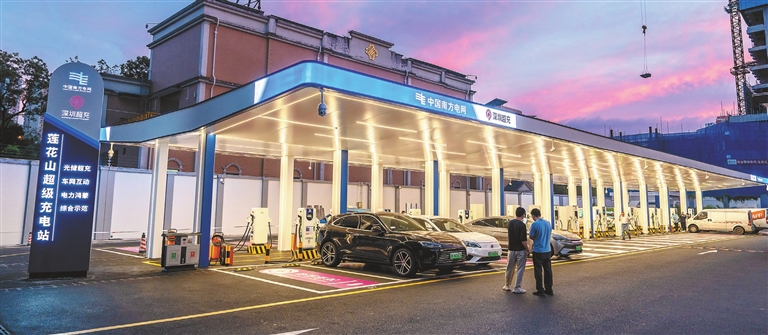
THE electric vehicle supercharging station at Lianhua Hill Park in Futian District is fueling a transition to green mobility with the low hum of flowing electricity. Since opening six months ago, the station has become the preferred pitstop for discerning new energy vehicle (NEV) drivers, attracting over 600 vehicles daily. As a steady stream of NEVs entered the station, a man surnamed Sun gestured toward his sedan, which was charging at a 600kW hypercharger. “An hour elsewhere takes just 20 minutes here,” he said. “This is Shenzhen speed.” Sun’s experience will be shared by millions of NEV owners across China in the coming years. According to official data, there were 31.4 million NEVs in China at the end of 2024 — more than half of the world’s total. Development of infrastructure like the supercharging station at Lianhua Hill Park is critical for China, which is the world’s largest NEV market. The station’s 27 charging points, including four record-setting 600kW hyperchargers, run near capacity. With a charging speed equal to one kilometer per second, the battery in an average family car can be charged to 80% within 10 minutes. For drivers like Sun, who visits Lianhua Hill Park twice a week, the difference is immense. “No lines, even at rush hour. It rewrites your schedule,” said Sun. Notably, the station is China’s first to integrate solar storage, hypercharging, vehicle-grid interaction, and the OpenHarmony for Power operating system. Its 152kW solar canopy and 200kWh battery storage bank combine to provide solar energy to the NEVs. However, its truly transformative potential lies in its vehicle-to-grid (V2G) capabilities. The station boasts 22 specialized charging piles that are equipped with V2G technology, providing 36 total outlets that allow NEVs to serve as mobile power units. A demonstration occurred in March 2025 during China’s largest V2G event, when the station discharged 13,000kWh into the grid per day — equivalent to the power needs of 1,600 households for a whole day. Drivers who take part in the V2G initiative earn 4 yuan (US$0.56) per kWh discharged, said Zhang Jiasen, a senior manager at Futian District’s power supply bureau. With off-peak charging calculated at 0.4 yuan per kWh, the benefit is clear — a net gain of 3.6 yuan per kWh. Managing the complexity of the V2G system requires robust software. Notably, five advanced piles at the station utilize OpenHarmony for Power, which is a domestically developed industrial-grade operating system. OpenHarmony for Power secures digital assets by enhancing the information security of charging and swapping equipment, allowing for more flexible and efficient networking of devices. (Xinhua) | 
